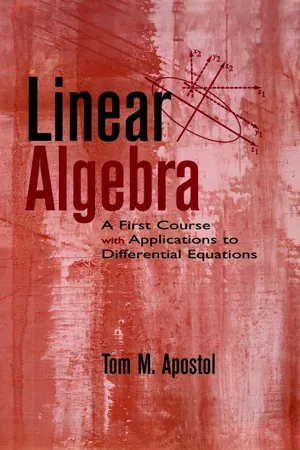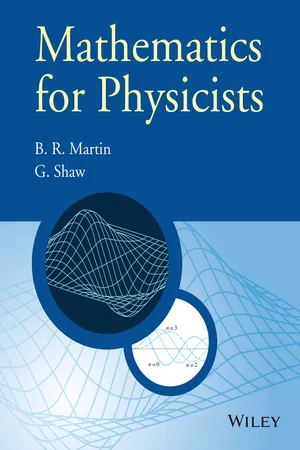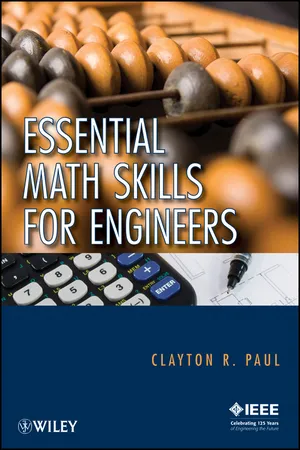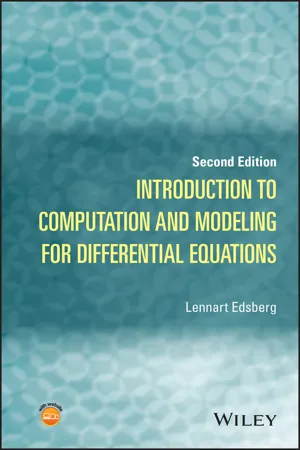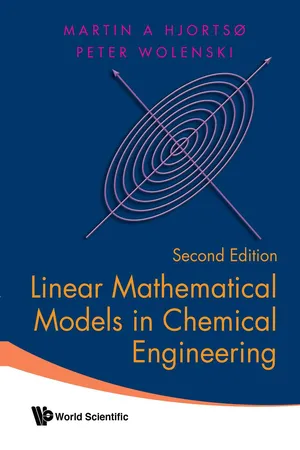Mathematics
Linear Differential Equation
A linear differential equation is an equation involving a function and its derivatives, where the function and its derivatives appear only in a linear manner. This means that the function and its derivatives are raised to the power of 1 and are not multiplied or divided by each other. Linear differential equations are important in various fields such as physics, engineering, and economics for modeling natural phenomena.
Written by Perlego with AI-assistance
Related key terms
Related key terms
1 of 4
Related key terms
1 of 3
7 Key excerpts on "Linear Differential Equation"
- eBook - ePub
Linear Algebra
A First Course with Applications to Differential Equations
- Tom M. Apostol(Author)
- 2014(Publication Date)
- Wiley-Interscience(Publisher)
8
APPLICATIONS TO Linear Differential EquationS
8.1 Introduction
One of the most important applications of linear algebra is to the study of differential equations. Differential equations arise naturally in the physical world when one tries to determine something from a knowledge of its rate of change. For example, we can try to find the position of a moving particle from a knowledge of its velocity (first derivative of position) or its acceleration (second derivative of position). Or, a radioactive substance disintegrates at a known rate and we try to determine the amount of material present at a given time. In examples like these, the problem is to determine an unknown function y = f (x ) from prescribed information about its derivatives y′ and/or y″ expressed as an equation, called a differential equation . Any function satisfying the differential equation is called a solution .The order of a differential equation is the order of the highest derivative that appears in the equation. Thus, the differential equation y′ = y is of first order, while y" + 16y = 0 is of second order. All solutions of y′ = y have the formy = cex, where c is any constant. All solutions of y" + 16y = 0 have the form y = c 1 cos 4x + c 2 sin 4x , where c 1 and c 2 are arbitrary constants.The history of differential equations began in the 17th century when Newton, Leibniz, and the Bernoullis solved some simple differential equations of first and second order arising from problems in geometry and mechanics. These early discoveries seemed to suggest that solutions of differential equations arising from geometric or physical problems could be expressed in terms of the familiar elementary functions of calculus. Much of the early work was aimed at developing ingenious techniques for solving differential equations by elementary means, that is to say, by addition, subtraction, multiplication, division, composition, and integration, applied only a finite number of times to the familiar functions of calculus. - eBook - ePub
- Brian R. Martin, Graham Shaw(Authors)
- 2015(Publication Date)
- Wiley(Publisher)
14 Ordinary differential equations Any equation that expresses the functional dependence of a variable y on its arguments x i (i = 1, 2, …) and the derivatives of y with respect to those arguments, is called a differential equation. Physical systems are almost always described by such equations. For example, a wave f (x, t) travelling with velocity in the x -direction obeys the wave equation (14.1a) while the motion of a simple pendulum of length l performing small oscillations θ satisfies (14.1b) where g is a constant. Equation (14.1a) contains partial derivatives because f is a function of more than one variable, and the equation is therefore called a partial differential equation (PDE). These will be discussed in Chapter 16. On the other hand, in Equation (14.1b) the quantity θ depends on the single variable t, and the equation is called an ordinary differential equation (ODE). It is these equations that are the subject of this chapter and the next. In what follows, we will usually refer to the independent variable as x and the corresponding dependent variable as y (x). Thus, in general, an ordinary differential equation is of the form (14.2) Examples of ODEs are: (14.3a) (14.3b) and (14.3c) It is convenient to classify ordinary differential equations by their order, degree and linearity. The order is defined as the order of the highest derivative in the equation. Thus, Equations (14.3a), (14.3b) and (14.3c) are first, second and third order, respectively. The degree of the equation is defined as the power to which the highest order derivative is raised after the equation is rationalised, that is, only integer powers remain. Thus, (14.3a) and (14.3b) are both first degree equations. Equation (14.3c) is of second degree because when the equation is rationalised, it becomes so that the highest derivative is d 3 y /d x 3 and it is raised to power 2 - eBook - ePub
Mathematical Modeling
Branching Beyond Calculus
- Crista Arangala, Nicolas S. Luke, Karen A. Yokley(Authors)
- 2018(Publication Date)
- Chapman and Hall/CRC(Publisher)
t is an independent variable. Furthermore, in an introductory differential equations course, we learned that a differential equation is any equation that contains a derivative, or differentials. Because differential equations can be used to define derivatives, or rates of change, they can be used to model virtually any quantity or system that changes over time. In this chapter, we’ll discuss how to build and solve a variety of differential equations models.When creating a differential equations model, the goal is to derive a mathematical representation of how a quantity of interest is changing. This quantity is the dependent variable in the equation, and is referred to as a state variable or state of the model. The independent variable from the differential equation usually represents a physical attribute such as time or distance. Other parameters or constants that are present within the model are referred to as parameters.Recall that a differential equation that is coupled with a set of additional constraints on the dependent variable and its derivatives at a particular input (called initial conditions) is called an initial value problem. When constructing a mathematical model using a differential equation, it is desirable to create a model that has a single unique solution rather than a family of solutions. Because of this aspect of the modeling process, the majority of the differential equations models that we will construct or encounter will be initial value problems. While modeling with differential equations, we may also encounter boundary value problems, which consist of a differential equation with additional constraints on the dependent variable and/or its derivatives at different inputs (called boundary conditions).Within the next sections of this chapter, we will discuss how to construct and solve differential equations models. One aspect of the construction process that we won’t discuss very much is the importance of making units match. When formulating a differential equation that will be used to represent physical processes, we must keep in mind that the units of the model must match the units of the physical process. For example, consider the following equation that is part of an SVIR disease model, - eBook - ePub
- Clayton R. Paul(Author)
- 2011(Publication Date)
- Wiley-IEEE Press(Publisher)
y(x). You should be alert to this throughout your engineering studies. It is embarrassing not to know how to solve the differential equationonce you have learned to solve the differential equationas there are no differences in their solutions. We will consider only first- and second-order differential equations, meaning that the highest-order derivative will be first or second, respectively. Although higher-order differential equations occur frequently in engineering systems, they are only slightly more tedious to solve. However, you can easily extend to higher-order differential equations the methods we develop for first- and second-order equations.The equation is said to be linear if neither x(t) nor its derivatives are raised to a power greater than 1, and no products of x(t) and its derivatives appear. Note that there is a significant difference betweend2 x(t)/dt2and[dx(t)/dt]2 :The first is a second-order derivative and the second is a first-order derivative that is squared. An example of a nonlinear differential equation isThe equation is constant-coefficient if a and b are constants that are not functions of t. An example of a non-constant-coefficient differential equationIf a differential equation is either (a) non-constant-coefficient and/or (b) nonlinear, it is extremely difficult to solve, and generally only numerical, approximate solutions are obtainable! As was the case with algebraic equations, nonlinear and/or time-varying (nonconstant coefficient) differential equationsoccur throughout all of the engineering disciplines. But because they are so difficult to solve that an attempt at hand solution yields little or no insight into how a system behaves, we generally resort to solving them numerically in an approximate fashion using a computer or a calculator. Numerical solutions of differential equations are discussed at the end of this chapter. Throughout all of this you should keep in mind that the primary goal is to use mathematical skills to determine what the equations governing the system are telling us about how the system behaves. - Lennart Edsberg(Author)
- 2015(Publication Date)
- Wiley(Publisher)
Chapter 2 Ordinary Differential Equations This chapter is not intended to be a thorough treatment of mathematical properties of ordinary differential equations (ODEs). It is rather an overview of some important definitions and concepts such as problem classification and properties of linear ODE systems with constant coefficients and stability. These matters are important for numerical analysis of methods solving ODE problems. For a more extensive treatment of ODEs, it is recommended to consult some mathematical textbook, e.g., one of those referenced at the end of this chapter. 2.1 Problem Classification A general way of formulating a first-order scalar ODE is 2.1 where is defined in some interval, bounded or unbounded, and is a solution if satisfies (2.1) for all in the interval. The variable is called the independent variable and is called the dependent variable. The derivative can also be denoted or. As we have already pointed out, the general solution of (2.1) contains an arbitrary constant. Hence, the general solution is a family of infinitely many solutions. If we prescribe an initial condition (IC), the constant is determined and we get a unique solution, a particular solution. A scalar ODE of second order can be written as 2.2 The general solution of (2.2) contains two arbitrary constants and, i.e.,. Therefore, we need two conditions to determine and to get a unique solution. These conditions can be given in various ways. One way is to specify at two different values of, i.e., at and : 2.3 This way of specifying boundary conditions (BCs) to the second-order ODE (2.2) is called a boundary value formulation, and (2.2) and (2.3) define a boundary value problem (BVP). Other possible types of BCs will be shown in Chapter 4. Another way to specify conditions is by ICs- Martin A Hjortsø, Peter Wolenski(Authors)
- 2018(Publication Date)
- WSPC(Publisher)
Difference equation models may occur in situations that have a build-in time step, such as calculation of compound interest or the dynamics of annual or daily changes of some variable. They can occur in models of periodic processes such as cell cycle models and are used in process control problems where the discrete sampling time of measuring devices make difference equations the natural choice of model. They also arise in models of staged processes in which case the counter no longer refers to time steps but to stage number. Some examples of difference equation models follow.A further rationale for studying difference equations is that the theory of linear difference equations is a good preamble to the study of linear ordinary differential equations. Linear ODEs are of course widespread in models of chemical engineering systems and it turns out that the theory of linear ODEs is strikingly similar to the theory of linear difference equations. Furthermore, it is easier to develop and comprehend the theory for difference equations than for differential equations, so an understanding of the simpler difference equations is a good basis for developing an understanding of the more difficult differential equations.The difference equations given are all examples of ODEs. They are called ordinary because the dependent variable is a function of only one counter. Problems in which the dependent variable is a function of several counters can also be found and these equations are known as partial difference equations. Partial difference equations will not be covered here.Example 7.1: High finance.After graduation your are left with a student loan that you have to pay off within some given period of time. Each month, interest accrues and each month you make a fixed payment on the loan. Determine the magnitude of this payment.For this problem, the counter τ has an obvious meaning; it is the number of months since you graduated. The amount left in the principal in month τ + 1 is xτ+1and is readily found from the amount left in month τ- eBook - ePub
Modeling Change and Uncertainty
Machine Learning and Other Techniques
- William P. Fox, Robert E. Burks(Authors)
- 2022(Publication Date)
- Chapman and Hall/CRC(Publisher)
5 Differential Equations DOI: 10.1201/9781003298762-5 OBJECTIVES Understand the typical models of ordinary differential equations. Understand the analytical solution techniques for separable and linear ODEs. Know the numerical methods. Understand the importance of slope fields. Understand the concept of correlation and linearity. Build and interpret nonlinear regression models. Build and interpret logistics regression models. Build and interpret Poisson regression models. 5.1 Introduction In this section, we introduce many mathematical models from a variety of disciplines. Our emphasis in this section is building the mathematical model, or expression, that will be solved later in the chapter. Recall previously that we discussed the modeling process. In this section, we will confine ourselves to the first three steps of the modeling process: (1) Identifying the problem, (2) Assumptions and Variables, and (3) Building the model. Example 5.1: Competition between Species Imagine a small fishpond supporting both trout and bass. Let T(t) denote the population of trout at time t and B(t) denote the population of bass at time t. We want to know if both can coexist in the pond. Although population growth depends on many factors, we will limit ourselves to basic isolated growth and the interaction with the other competing species for the scarce life-support resources. We assume that the species grow in isolation. The level of the population of the trout or the bass, B(t) and T(t), depend on many variables such as their initial numbers, the amount of competition, the existence of predators, their individual species birth and death rates, and so forth. In isolation we assume the following proportionality models (following the same arguments as the basic populations models that we have discussed before) to be true where the environment can support an unlimited number of trout and/or bass
Index pages curate the most relevant extracts from our library of academic textbooks. They’ve been created using an in-house natural language model (NLM), each adding context and meaning to key research topics.
Explore more topic indexes
Explore more topic indexes
1 of 6
Explore more topic indexes
1 of 4
